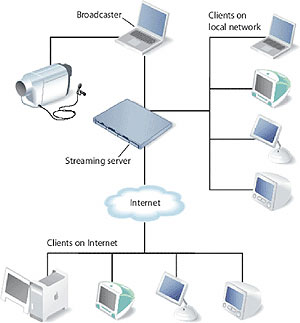
Prolearn Live
|
Webcasting Key Elements ProLearn Live Trails Articles |
Webcasting can be viewed as television broadcasting over the Internet, with a single source being broadcast to a large number of viewers. Like television, it carries with it an association with a quality video and audio experience for the participant, who is relatively passive and is taking part at scale. In general it is also associated with lecture-like or strongly presentational formats, although there is also often a local participation (as in a “studio audience”) who are used to represent the larger body of remote participants.
Figure 1 – A basic webcast network diagram (Apple™ 2006) From a technical point of view, webcasting involves the capture of video (and audio) by a PC (or dedicated encoder) that is then encoded to reduce the bandwidth requirements for transmission over the internet, this stream of data is then sent in real time to a streaming server where it is distributed to end viewers, who can watch the video in real time, or view the recording of the event later. Webcasting consists of five principle elements, video/audio source, encoder, network, streaming server, webcast clients (see Figure 1). |
Contact: Kevin Quick |
|
| Home |
News |
